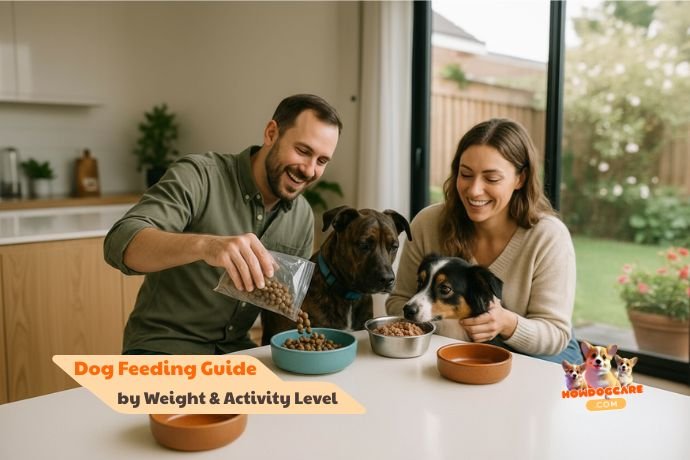Feeding your dog isn’t as simple as scooping out some kibble and calling it a day. Dogs, just like people, have unique dietary needs based on factors like their weight, energy level, age, and even breed. If you’re still guessing how much to feed your furry best friend, you’re not alone. Many dog owners struggle to create a balanced diet that matches their pet’s individual lifestyle. That’s where a Custom Dog Feeding Guide comes in handy.
This guide will help you understand how to tailor your dog’s feeding routine to fit their body weight and activity level, ensuring they stay energetic, lean, and healthy for the long haul. Whether you’ve got a couch-loving chihuahua or a high-energy husky, we’ve got you covered.
Understanding Your Dog’s Nutritional Needs
Why Every Dog Needs a Custom Feeding Plan
Just like people, dogs come in all shapes, sizes, and activity levels. A one-size-fits-all approach to feeding doesn’t cut it. Imagine trying to fuel a marathon runner and someone with a desk job using the same meal plan—it wouldn’t work! Dogs are the same. A dog’s daily food intake should be uniquely suited to their size, metabolism, energy output, and health status.
A custom feeding plan takes into account your dog’s:
- Weight
- Breed
- Age
- Activity level
- Health conditions
- Preferences
Feeding too much can lead to obesity, joint problems, and diabetes. Feeding too little may cause nutrient deficiencies, fatigue, and a weakened immune system. A Custom Dog Feeding Guide helps strike the right balance for optimal health.
Moreover, nutrition impacts everything from your dog’s coat quality and stool consistency to their energy levels and mood. With a tailored feeding strategy, you’ll notice a happier, healthier pup that’s thriving—not just surviving.
Factors That Affect a Dog’s Diet
Every dog’s body processes food differently. There are a few critical factors that influence how much and what kind of food your dog needs. Here are some key considerations:
- Weight & Body Condition Score (BCS): A dog’s weight isn’t enough on its own. Vets use BCS to evaluate fat distribution and muscle tone. An over_weight dog needs fewer calories, while an underweight pup needs more.
- Age: Puppies, adults, and senior dogs all have different nutritional needs. Puppies need more protein and calories, while senior may need less fat and more joint support.
- Activity Level: A couch potato doesn’t burn as many calories as an agility champion. Activity level is a major factor in determining how much to feed.
- Breed & Metabolism: Some breeds are prone to weight gain while others burn through calories faster. For instance, a Labrador Retriever might need fewer calories than a lean and lanky Greyhound of the same weight.
- Health Conditions: Dogs with diabetes, kidney disease, or food allergies need specific diets. Always consult your vet if your dog has a medical condition.
- Spay/Neuter Status: Hormonal changes can affect metabolism. Spayed or neutered dogs often require fewer calories.
By analyzing these factors, you can begin to understand why your dog needs a diet that’s as unique as they are. A custom feeding plan isn’t just helpful—it’s essential for long-term health and happiness.
How Weight Impacts Dog Feeding Requirements
Feeding Guidelines for Small Breeds

Small breed dogs, typically under 20 pounds, may have fast metabolisms and require more calories per pound than larger breeds. But that doesn’t mean you should pile up their bowls! Because of their tiny size, even slight overfeeding can lead to obesity fast.
Here’s a general guide for small breeds:
- Weight: 5–20 lbs
- Calories Needed (Inactive): 200–400 kcal/day
- Calories Needed (Active): 300–600 kcal/day
Some examples of small breeds include:
- Chihuahuas
- Pomeranians
- Shih Tzus
- Dachshunds
- Miniature Poodles
Small dogs also tend to have smaller stomachs, so feeding them twice or even three times a day can help prevent digestive issues and maintain energy levels. Choose nutrient-dense food specially formulated for small breeds—it typically comes in smaller kibble sizes, making it easier for them to chew and digest.
Also, small breeds are more prone to dental issues, so dry kibble is often recommended to help with tartar control. When using a Custom Dog Feeding Guide, always consider both the calorie content per cup of food and your dog’s individual caloric needs—not just the amount of food in the bowl.
Feeding tips:
- Break meals into smaller portions
- Avoid table scraps and high-fat treats
- Keep an eye on body shape, not just the scale
Feeding Guidelines for Medium-Sized Dogs
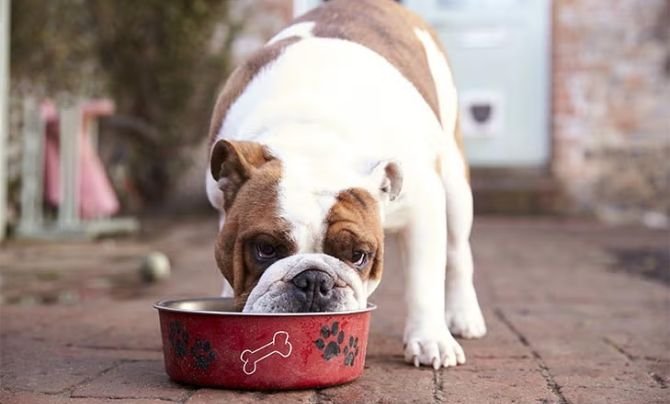
Medium-sized dogs (typically 21–50 pounds) make up a broad category. These dogs need balanced meals that support both lean muscle and joint health, especially if they are moderately active.
Typical calorie needs:
- Weight: 20–50 lbs
- Calories Needed (Inactive): 500–900 kcal/day
- Calories Needed (Active): 700–1,200 kcal/day
Examples of medium breeds:
- Beagles
- Cocker Spaniels
- Border Collies
- Bulldogs
Medium dogs are often overlooked when it comes to specialized feeding. But their nutritional needs are just as important as any other size. Many active medium-sized dogs require diets rich in protein and healthy fats to fuel their movement.
Make sure you:
- Use measuring cups (not just eyeball the food)
- Adjust portions if your dog gains or loses weight
- Choose a diet rich in omega-3s for coat and joint health
When referencing a Custom Dog Feeding Guide, it’s essential to also consider the specific lifestyle of the dog. For instance, a Bulldog who enjoys lounging all day won’t need the same intake as a Border Collie that’s always on the move.
Feeding Guidelines for Large and Giant Breeds
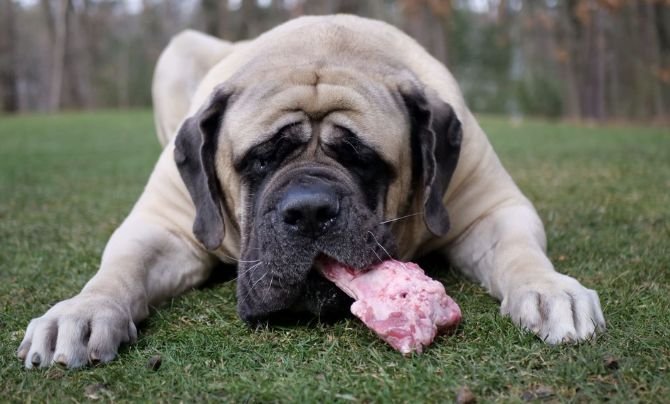
Feeding a large or giant breed dog requires extra thought. These dogs grow fast and have specific needs to support healthy joints, bones, and muscles. Overfeeding can lead to hip dysplasia, arthritis, and other serious health issues.
Large breed calorie needs:
- Weight: 50–100+ lbs
- Calories Needed (Inactive): 1,000–1,600 kcal/day
- Calories Needed (Active): 1,800–2,500 kcal/day
Common large breeds:
Special feeding considerations:
- Feed large breeds with formulas labeled “Large Breed” to manage calcium and phosphorus levels
- Split daily meals into 2–3 smaller portions to prevent bloat (gastric torsion)
- Monitor growth in puppies to avoid growing too fast, which stresses the joints
A Custom Dog Feeding Guide for large dogs focuses not just on how much to feed, but also what kind of food to offer. Look for glucosamine, chondroitin, and controlled calories in their formula.
How Activity Level Changes Caloric Needs
Low-Energy Dogs (Couch Potatoes)
Not all dogs are running marathons around your yard. Some prefer lounging on the couch and napping the day away. These low-energy dogs—often older pets or less active breeds—burn fewer calories and, as a result, require fewer to stay healthy.
Signs your dog is low-energy:
- Prefers naps over playtime
- Reluctant to go on long walks
- Spends most of the day sedentary
Caloric needs for low-energy dogs:
- Small (5–20 lbs): 180–350 kcal/day
- Medium (20–50 lbs): 400–750 kcal/day
- Large (50–100+ lbs): 800–1,400 kcal/day
Breeds known for lower energy:
- Basset Hounds
- Bulldogs
- Shih Tzus
- Great Danes (despite their size, they’re quite mellow)
Feeding a low-energy dog too much is a recipe for weight gain. Follow these tips:
- Choose low-calorie or weight management formulas
- Avoid high-carb treats and table food
- Stick to a strict feeding schedule
Also, consider that these dogs may be prone to joint issues and diabetes if higher weight. The Custom Dog Feeding Guide should emphasize portion control and foods that support joint and heart health. Incorporate light daily exercise to keep metabolism active and prevent boredom that can lead to overeating.
Moderately Active Dogs
This group includes the majority of family pets. They enjoy daily walks, playtime in the yard, and occasional hikes or runs. Moderately active dogs need more calories than low-energy dogs but still require controlled feeding to avoid excess weight.
Daily calorie ranges:
- Small (5–20 lbs): 250–450 kcal/day
- Medium (20–50 lbs): 700–1,000 kcal/day
- Large (50–100+ lbs): 1,400–2,000 kcal/day
Common moderately active breeds:
- Labrador Retrievers
- Cocker Spaniels
- Golden Retrievers
- Australian Shepherds
Moderate activity is perfect for most dogs, but keep in mind:
- Treats should not exceed 10% of daily intake
- Meals should include lean proteins and healthy fats
- Monitor body condition regularly to adjust food amounts
Use a Custom Dog Feeding Guide to find the balance between keeping your dog fueled and avoiding overfeeding. These dogs thrive on quality nutrition and consistent routines.
High-Energy or Working Dogs
Dogs in this category are the athletes of the canine world. Think hunting dogs, sled dogs, herding breeds, or pups that participate in agility, flyball, or search and rescue. These dogs burn serious calories and need higher fuel to match.
Examples of high-energy breeds:
- Border Collies
- Belgian Malinois
- Siberian Huskies
- Vizslas
- German Shorthaired Pointers
Calorie needs:
- Small (5–20 lbs): 400–600 kcal/day
- Medium (20–50 lbs): 900–1,500 kcal/day
- Large (50–100+ lbs): 2,000–3,000+ kcal/day
Feeding high-energy dogs requires:
- High-protein, high-fat diets
- Multiple meals or free feeding during heavy training
- Close monitoring of weight and performance
Their feeding schedule may need adjusting seasonally, especially if their work or training intensity changes. A proper Custom Dog Feeding Guide ensures these dogs don’t burn out or become malnourished from underfeeding.
Custom Dog Feeding Guide: By Weight & Activity Level
Table: Daily Feeding Amounts Based on Weight & Activity
To help make feeding your dog easier, here’s a general feeding chart combining weight and activity levels. Keep in mind, individual brands have different calorie counts, so always check labels.
| Dog Weight | Low Energy (kcal/day) | Moderate Energy (kcal/day) | High Energy (kcal/day) |
|---|---|---|---|
| 5–10 lbs | 180–250 kcal | 250–350 kcal | 350–500 kcal |
| 11–20 lbs | 250–350 kcal | 350–450 kcal | 450–600 kcal |
| 21–50 lbs | 400–750 kcal | 750–1,000 kcal | 1,000–1,500 kcal |
| 51–100 lbs | 800–1,400 kcal | 1,400–2,000 kcal | 2,000–3,000+ kcal |
Use this chart with your food label to determine how many cups or grams to serve daily. Adjust portions if your dog gains or loses weight.
How to Measure Dog Food Accurately
“Eyeballing” your dog’s food is one of the most common feeding mistakes. Always use measuring tools for precision. Here’s how:
- Dry Food: Use an 8 oz measuring cup (standard)
- Wet Food: Check can label for kcal/can
- Raw/Homemade: Use a kitchen scale for accuracy
Extra tips:
- Always read the feeding guide on your food package
- Feed based on your dog’s ideal weight, not current weight if over_weight
- Adjust gradually if changing feeding amounts
A Custom Dog Feeding Guide should always encourage accurate measurements to prevent over- or underfeeding.
Adjusting Portions for Age and Breed
Your dog’s nutritional needs will change over time. Puppies need more calories, while senior dogs require fewer. Similarly, breed-specific traits affect how much food your dog needs.
- Puppies: Often need up to 2x the calories of adults
- Senior: May need up to 20% fewer calories
- Breed-Specific Needs: Some breeds like Dobermans or Greyhounds are naturally lean; others like Labradors or Beagles are prone to obesity
Custom feeding means evolving your dog’s diet as they age or as their lifestyle changes. Monitor regularly and adjust as needed. A vet or canine nutritionist can help you develop a breed- and age-specific feeding plan based on your dog’s profile.
Types of Dog Food and Their Impact on Feeding
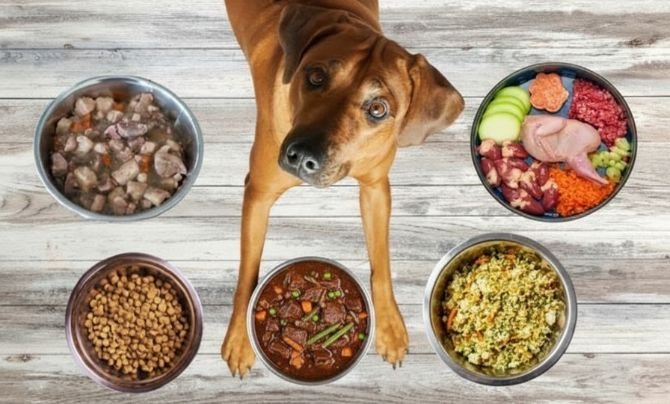
Dry Kibble vs. Wet Food
When it comes to feeding your dog, the first big decision many owners face is: kibble or canned? Each has its pros and cons, and your choice can influence how much you should feed your dog.
Dry Kibble:
- Most common choice
- More calorie-dense, meaning smaller portions
- Helps with dental health by reducing tartar
- Easy to store and measure
- Less expensive over time
Wet Food:
- More appealing to picky eaters
- Higher moisture content (good for hydration)
- Lower in calories per ounce
- Can be messy and more expensive
- Requires refrigeration once opened
If you’re feeding only wet food, your dog may need a higher volume to meet calorie requirements. For example, 1 cup of kibble might be 350 kcal, while a can of wet food may only provide 150–200 kcal.
Some owners opt for a mixed feeding plan, using both kibble and wet food for variety and balance. The key is to adjust portion sizes accordingly so your dog doesn’t get too many or too few calories. A Custom Dog Feeding Guide should always reflect the calorie density of the chosen food type.
Raw Diets and Homemade Meals
Raw and homemade diets are becoming more popular, but they come with a need for precision and knowledge. These feeding styles give you control over every ingredient, but that freedom can also lead to nutritional imbalances if you’re not careful.
Pros of raw/homemade:
- Full control over ingredients
- Great for dogs with food sensitivities
- Often more palatable for dogs
Cons:
- Time-consuming to prepare
- Must be carefully balanced to avoid deficiencies
- Raw meat can pose a health risk to dogs and humans if not handled properly
- More expensive
If you go this route, consult with a veterinary nutritionist. Homemade food should be tailored to your dog’s weight, age, and activity level—no guesswork. A Custom Dog Feeding Guide becomes essential here to ensure your dog receives the right proportions of protein, fat, and carbohydrates, along with vital vitamins and minerals.
Grain-Free vs. Grain-Inclusive Options
Another common debate is whether to feed grain-free or grain-inclusive diets. Some owners choose grain-free because they believe grains cause allergies or digestive issues, while others stick to traditional, vet-approved grain-inclusive diets.
Grain-Free Diets:
- Often contain potatoes or legumes instead
- Good for dogs with confirmed grain allergies
- Some links to heart issues in certain breeds (DCM concerns)
Grain-Inclusive Diets:
- Balanced and time-tested
- Usually more affordable
- Provide a good source of energy
Unless your dog has been diagnosed with a grain allergy, most dogs tolerate grains well. Whole grains like brown rice and oats offer fiber and energy. A Custom Dog Feeding Guide should account for your dog’s tolerance to grains and adjust macros accordingly.
Special Diets and Feeding Considerations
Dogs with Allergies or Sensitivities
If your dog scratches excessively, has frequent ear infections, or experiences chronic upset stomach, food allergies could be the culprit. Common culprits include:
- Beef
- Dairy
- Chicken
- Wheat
- Soy
- Corn
Elimination diets are usually the first step in identifying the allergen. Hypoallergenic or limited-ingredient diets help reduce flare-ups. These foods tend to have:
- Novel proteins (like duck or venison)
- Limited ingredients to reduce potential allergens
- No artificial additives or fillers
A Custom Dog Feeding Guide for dogs with allergies must be strict and consistent. Avoid rotating between different foods or giving treats that might contain hidden allergens. Check every label and ingredient list thoroughly.
Senior Dogs and Puppies
Different life stages = different needs. A puppy’s growth demands are vastly different from a senior dog’s maintenance requirements.
Puppies:
- Require higher calories, protein, and fat
- Need DHA for brain development
- Should eat 3–4 small meals daily
- Should transition to adult food around 12 months
Senior:
- Require fewer calories but more joint support (glucosamine, chondroitin)
- May benefit from fiber to aid digestion
- Often need softer food due to dental issues
Both life stages need tailored feeding approaches, especially when combined with weight or activity variations. A Custom Dog Feeding Guide should evolve with your dog’s age.
Medical Conditions That Require Custom Feeding
Dogs with health issues may need therapeutic diets. Always follow your veterinarian’s recommendation, but here are some common dietary needs by condition:
- Diabetes: Low glycemic foods, consistent feeding schedule
- Kidney Disease: Low-protein, low-phosphorus diets
- Heart Disease: Low sodium, controlled fat
- Pancreatitis: Low-fat, highly digestible foods
- Obesity: Calorie-restricted diets, high fiber
Special diets are non-negotiable for dogs with medical conditions. Don’t rely on generic feeding guides—use a veterinary-approved Custom Dog Feeding Guide for your dog’s specific illness.
Related Articles
- Orijen vs Acana vs Taste of the Wild: Which Dog Food Brand Reigns in 2026?
- Top 10 Best Dog Car Seat Cover ‒ Back Seat Clean & Protected
- Top 8 Best Flea Collar for Dogs Reviews & Buyer’s Guide
- How To Dog Clicker Training: Train Smarter, Not Harder
- Top 10 Best Large Dog Food Dispensers in 2026 Reviews & Guide
- Human-Grade Dog Food (2026): Benefits, Costs & Top 10 Brands
How to Switch Your Dog’s Food Safely
Transition Schedule for New Foods
Changing your dog’s food abruptly can wreak havoc on their digestive system. A gradual transition helps prevent diarrhea, vomiting, and refusal to eat.
7-Day Transition Schedule:
- Days 1–2: 75% old food + 25% new food
- Days 3–4: 50% old food + 50% new food
- Days 5–6: 25% old food + 75% new food
- Day 7+: 100% new food
Use this schedule any time you switch brands, protein sources, or feeding styles. It gives your dog’s gut time to adjust and helps you spot any intolerance issues early.
Monitoring Digestive Health During Switch
During the transition, monitor for:
- Loose stools
- Vomiting
- Gas
- Refusal to eat
- Changes in energy or mood
Keep a journal to track your dog’s reactions. If symptoms persist beyond a few days or worsen, go back a step or consult your vet. A well-planned Custom Dog Feeding Guide includes transition periods and digestive health checks.
Feeding Mistakes to Avoid
Overfeeding and Underfeeding Risks
One of the biggest and most common mistakes dog owners make is misjudging how much their dog actually needs to eat. Unfortunately, both overfeeding and underfeeding come with serious consequences that affect your dog’s overall health and quality of life.
Overfeeding:
It’s easy to overfeed, especially when you rely on guesswork or allow free feeding (leaving food out all day). Dogs that are overfed may show signs such as:
- Excessive weight gain
- Lethargy
- Labored breathing
- Joint stress or difficulty walking
Long-term effects of overfeeding include:
- Obesity
- Diabetes
- Arthritis
- Heart disease
- Shortened lifespan
Underfeeding:
On the flip side, underfeeding can be just as dangerous. Dogs that don’t get enough calories or nutrients may experience:
- Lethargy or low energy
- Muscle loss
- Weakened immune system
- Dull coat or hair loss
These dogs may constantly act hungry and display begging behaviors. If your dog is losing weight or seems undernourished, reevaluate the calorie count and nutrient profile of their food using a Custom Dog Feeding Guide.
How to avoid these mistakes:
- Always measure food accurately using a cup or scale
- Adjust portions based on weight changes and activity level
- Avoid using human food as treats—it’s often calorie-dense
- Follow your vet’s advice for optimal feeding
A good rule of thumb is to monitor your dog’s body condition, not just their weight. Look for visible waistlines and ribs that can be felt but not seen. The Custom Dog Feeding Guide should be adjusted every few months based on your dog’s changing needs.
Free Feeding vs. Scheduled Feeding
Feeding style is another key factor in a dog’s diet success. The two primary methods are free feeding and scheduled feeding—each with its own pros and cons.
Free Feeding:
- Food is available all day
- Works best with dry food only
- Can lead to overeating and weight gain
- Makes it difficult to monitor exact intake
- May cause food guarding or dominance issues in multi-dog households
Scheduled Feeding:
- Meals are given at set times (usually 2–3x per day)
- Easier to control portions and monitor appetite
- Helps with housetraining puppies
- Encourages healthy digestion
- Builds routine and structure
Most veterinarians and canine nutritionists recommend scheduled feeding, especially when following a Custom Dog Feeding Guide. It allows you to:
- Notice appetite changes that could signal illness
- Control how much food your dog eats
- Manage feeding around medication schedules
Ultimately, scheduled feeding creates better habits, prevents obesity, and promotes a more balanced lifestyle for your dog.
Supplements and Treats: How Much is Too Much?
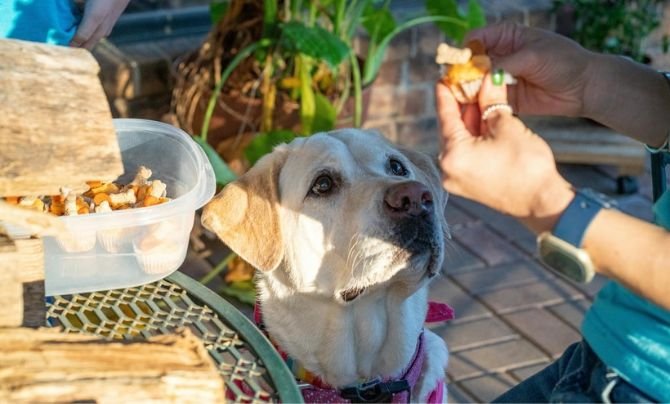
Choosing Healthy Dog Treats
Dog treats are great for training, bonding, and rewarding good behavior—but they should never become the main source of your dog’s calories. Overuse of treats is a sneaky contributor to weight gain and nutrient imbalance.
Here’s how to choose healthy treats:
- Low in calories: Look for treats under 10 kcal each
- Limited ingredients: Avoid artificial flavors and colors
- Functional benefits: Choose treats with dental, joint, or digestive support
- Made in trusted countries: Prefer USA, Canada, or EU-sourced products
Treats should make up no more than 10% of your dog’s total daily calories. If your dog eats 800 kcal/day, that means only 80 kcal should come from treats. The rest should come from their balanced main meals.
You can also use non-food rewards like:
- Playtime
- Extra walks
- Praise and petting
The best Custom Dog Feeding Guide includes treat calorie tracking and healthy alternatives like frozen green beans, carrot slices, or apple chunks (without seeds).
When to Consider Supplements
Supplements should only be added if your dog’s regular diet lacks something essential or they have a specific health condition. Here are some common supplements and when to use them:
- Glucosamine & Chondroitin: For joint health, especially in older or large breeds
- Fish Oil (Omega-3): For skin, coat, heart, and cognitive function
- Probiotics: For digestive health and immunity
- Multivitamins: Only if feeding a homemade or unbalanced diet
- Fiber supplements: For dogs with irregular bowel movements
Be cautious with supplements. Over-supplementation can cause more harm than good. Always consult your vet before starting any new supplement, especially if your dog is already on a vet-prescribed diet. A tailored Custom Dog Feeding Guide may already account for many of the nutrients these supplements provide.
Signs Your Dog’s Diet Needs Adjusting

Behavioral and Physical Indicators
Dogs can’t speak, but their body language and behavior offer clear signs when their diet is out of sync. Watch for these red flags that suggest it’s time to tweak their feeding routine:
Behavioral signs:
- Constant begging or scavenging
- Lethargy or hyperactivity
- Sudden aggression or irritability
- Pacing or restlessness after meals
Physical signs:
- Weight gain or loss
- Dry or flaky skin
- Dull coat or excessive shedding
- Frequent vomiting or diarrhea
- Bad breath
- Changes in stool consistency or frequency
Any of these signs could point to either overfeeding, underfeeding, poor-quality food, or an allergic reaction. A Custom Dog Feeding Guide helps diagnose these issues early by giving you a structured framework to track and measure.
When to Consult a Veterinarian
Sometimes, despite our best efforts, things go wrong. If your dog continues to show signs of distress or health decline despite feeding adjustments, it’s time to bring in the pros.
Contact your vet if:
- Your dog is losing or gaining weight without explanation
- Skin or coat issues persist
- Your dog refuses food for more than 24 hours
- Vomiting or diarrhea lasts longer than 48 hours
- You suspect a food allergy or intolerance
- You need help balancing a homemade or raw diet
A vet can conduct diagnostics like blood work or allergy testing and help build a Custom Dog Feeding Guide tailored to your pup’s exact needs.
Conclusion: Build a Healthy, Personalized Feeding Routine
Feeding your dog isn’t just about filling a bowl—it’s about fueling a life. Every dog is unique, and their feeding plan should reflect their individual weight, activity level, age, health status, and lifestyle.
By using a Custom Dog Feeding Guide, you gain the power to:
- Maintain a healthy weight
- Support immune and digestive health
- Boost energy and mood
- Prevent long-term health issues
- Enhance your dog’s quality of life
Remember, it’s not about feeding more or less—it’s about feeding right. Invest the time to understand your dog’s specific needs, choose high-quality food, measure portions accurately, and adjust as needed. Your dog will thank you with a wagging tail, a shiny coat, and a long, healthy life by your side.
FAQs About Custom Dog Feeding Plans
How do I know if I’m feeding my dog the right amount?
Check their body condition: ribs should be easily felt but not visible, with a visible waistline. Monitor their weight monthly and adjust based on activity and health.
Can I mix wet and dry food for my dog?
Yes! Many owners use a 50/50 mix or top kibble with a spoonful of wet food. Just calculate total calories so you don’t overfeed.
Should I switch my dog’s food regularly?
Frequent changes aren’t necessary unless recommended by a vet. If switching, do so gradually over 7–10 days to avoid digestive upset.
Are grain-free diets better for dogs?
Not necessarily. Unless your dog has a diagnosed grain allergy, grain-inclusive diets are safe and often better balanced.
How often should I update my dog’s feeding plan?
Review your Custom Dog Feeding Guide every 3–6 months, or after major life changes like weight gain/loss, aging, or changes in activity level.


